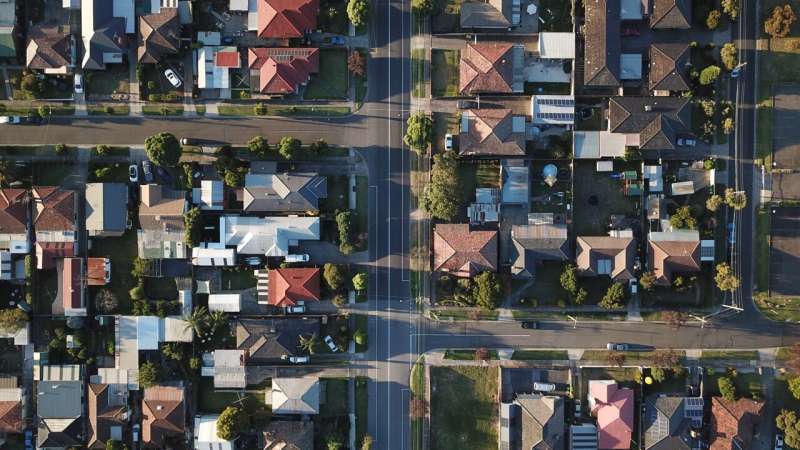This article has been reviewed according to Science X's editorial process and policies. Editors have highlighted the following attributes while ensuring the content's credibility:
fact-checked
trusted source
proofread
Study finds US does not have housing shortage, but shortage of affordable housing

The United States is experiencing a housing shortage. At least, that is the case according to common belief—and is even the basis for national policy, as the Biden administration has stated plans to address the housing supply shortfall.
But new research from the University of Kansas finds that most of the nation's markets have ample housing in total, but nearly all lack enough units affordable for very low-income households.
Kirk McClure, professor of public affairs & administration emeritus at KU, and Alex Schwartz of The New School have now co-written a study published in the journal Housing Policy Debate. They examined U.S. Census Bureau data from 2000 to 2020 to compare the number of households formed to the number of housing units added to determine if there were more households needing homes than units available.
The researchers found that only four of the nation's 381 metropolitan areas experienced a housing shortage in the study time frame, as did only 19 of the country's 526 "micropolitan" areas—those with 10,000-50,000 residents.
The findings suggest that addressing housing prices and low incomes is more urgently needed to address housing affordability issues than simply building more homes, the authors wrote.
"There is a commonly held belief that the United States has a shortage of housing. This can be found in the popular and academic literature and [that] from the housing industry," McClure said. "But the data shows that the majority of American markets have adequate supplies of housing available. Unfortunately, not enough of it is affordable, especially for low-income and very low-income families and individuals."
McClure and Schwartz also examined households in two categories: Very low income, defined as between 30% and 60% of area median family income, and extremely low income, with incomes below 30% of area median family income.
The numbers showed that from 2010 to 2020, household formation did exceed the number of homes available. However, there was a large surplus of housing produced in the previous decade. In fact, from 2000 to 2020, housing production exceeded the growth of households by 3.3 million units. The surplus from 2000 to 2010 more than offset the shortages from 2010 to 2020.
The numbers also showed that nearly all metropolitan areas have sufficient units for owner occupancy. But nearly all have shortages of rental units affordable for very low-income renter households.
While the authors looked at housing markets across the nation, they also examined vacancy rates, or the difference between total and occupied units, to determine how many homes were available. National total vacancy rates were 9% in 2000 and 11.4% by 2010, which marked the end of the housing bubble and the Great Recession. By the end of 2020, the rate was 9.7%, with nearly 14 million vacant units.
"When looking at the number of housing units available, it becomes clear there is no overall shortage of housing units available. Of course, there are many factors that determine if a vacant [unit] is truly available; namely, if it is physically habitable and how much it costs to purchase or rent the unit," McClure said. "There are also considerations over a family's needs, such as an adequate number of bedrooms or accessibility for individuals with disabilities, but the number of homes needed has not outpaced the number of homes available."
Not all housing markets are alike, and while there could be shortages in some, others could contain a surplus of available housing units. The study considered markets in all core-based statistical areas as defined by the Census Bureau. Metropolitan areas saw a nationwide surplus of 2.7 million more units than households in the 20-year study period, while micropolitan areas had a more modest surplus of about 300,000 units.
Numbers of available housing units and people only tell part of the story. An individual family needs to be able to afford housing, whether they buy or rent. Shortages of any scale appear in the data only when considering renters, the authors wrote. McClure and Schwartz compared the number of available units in four submarkets of each core-based statistical area to the estimated number of units affordable to renters with incomes from 30% to 60% of the area's median family income. Those rates are roughly equivalent to the federal poverty level and upper level of eligibility for various rental assistance programs. Only two metropolitan areas had shortages for very-low-income renters, and only two had surpluses available for extremely-low-income renters.
Helping people afford the housing stock that is available would be more cost-effective than expanding new home construction in the hope that additional supply would bring prices down, the authors wrote. Several federal programs have proven successful in helping renters and moderate-income buyers afford housing that would otherwise be out of reach.
"Our nation's affordability problems result more from low incomes confronting high housing prices rather than from housing shortages," McClure said. "This condition suggests that we cannot build our way to housing affordability. We need to address price levels and income levels to help low-income households afford the housing that already exists, rather than increasing the supply in the hope that prices will subside."
More information: Kirk McClure et al, Where Is the Housing Shortage?, Housing Policy Debate (2024). DOI: 10.1080/10511482.2024.2334011
Provided by University of Kansas





















